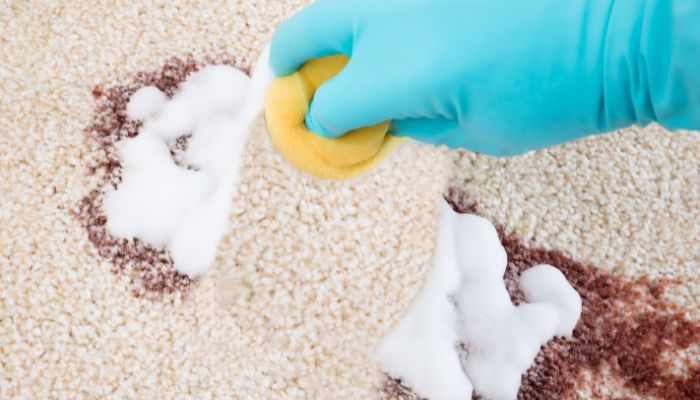How to Get Rid of Blood from Carpets: A Step-By-Step Guide

TLDR: This blog provides a comprehensive guide on how to effectively remove blood stains from carpets, whether they are fresh or dried. It outlines the tools and materials you’ll need and offers precautions for different carpet materials. The guide covers various effective blood stain removers like dishwashing liquid, ammonia, and hydrogen peroxide. It provides step-by-step instructions for removing fresh and set-in blood stains, emphasizing the importance of blotting and proper drying techniques. It also mentions the option of professional cleaning for stubborn stains.
Blood stains on carpets can be a troubling sight, but fear not! With the proper techniques, you can easily remove even the dried-up stains and make your carpet spotless. Whether the blood stain is fresh or has already dried, this step-by-step guide will guide you through removing blood stains from carpets, regardless of the type of carpet material. So, let’s dive in and discover the best methods for tackling this common household problem.
Tools and Materials You’ll Need
Before we start, we recommend gathering all the necessary tools and materials to ensure a smooth and efficient cleaning process. Here’s what you’ll need:
- Clean paper towels
- Clean white rag
- Stain remover
- Cold water
- Large bowl
- Stiff brush
It’s important to note that different carpet materials require different cleaning approaches. A safe approach is to read the carpet manufacturer’s care instructions. Also, do a patch test before using any stain remover on your carpet. Once you ensure you have the right tools and materials, you can move on to cleaning the stain.
Precautions with Different Carpet Materials
Each carpet material has unique characteristics and requires specific care. Understanding the precautions for different carpet materials will help you pick the suitable blood stain remover. Here’s what you need to know about cleaning different types of carpet:
- Wool: Wool carpets require a gentle treatment to avoid damaging the pile. Removing stains from woolen carpets requires gently blotting the spot instead of aggressively scrubbing. Remember that wool tends to retain moisture, so only use as much water as necessary to treat the stain.
- Nylon: Nylon is prone to fading and discoloration, so it’s essential to do a patch test before cleaning it with any cleaning agent. The test involves using the cleaner on a small patch out of sight first but only doing it with blotting. Rubbing can cause significant damage to the pile.
- Acrylic: Acrylic carpets can stain as soon as some liquid touches them. In this case, speed is everything, so promptly addressing blood stains is essential.
- Polyester: Polyester carpets are easiest to maintain as they rarely stain. However, if you ever see a stain on your carpet, blotting should be your cleaning method of choice.
- Olefin: Olefin carpets are considered stain-resistant due to their production process. However, avoid rough scrubbing on an olefin carpet and opt for blotting in case of blood stains.
Choosing an Effective Blood Stain Remover
Blood stains can be very stubborn because of the hemoglobin in the blood, which acts as a binder. When opting for a blood stain remover, it’s essential to choose one suitable for your specific situation. Some effective options include:
- Dishwashing Liquid: Dishwashing liquid can be a stain remover and clean dry and fresh blood stains on carpets. Just one tablespoon of dishwashing liquid with two cups of water can do the trick. Be sure to use cold water, as hot water can set the stain.
- Ammonia: If dishwashing liquid doesn’t thoroughly remove a dried blood stain, you can try using a solution of 1/2 cup of lukewarm water and one tablespoon of ammonia. Put the mixture on the spot and blot it using a cloth dipped in cold water. Don’t use this option on wool carpets.
- Hydrogen Peroxide: Hydrogen peroxide breaks up the chemical bonds in blood, making it colorless. It may require several applications, but it can be used on fresh and dried blood stains on carpets.
With the knowledge of the most effective blood stain removers, it is time to get to the meat and potatoes of this article: addressing how to get rid of blood from carpets.
How to Remove Fresh Blood Stains From Carpets
Acting quickly is crucial when dealing with fresh blood stains on carpets. Next up, we have a detailed guide with instructions on how to remove blood stains effectively without causing damage to the carpet fibers:
Blot Away Excess Blood
Start by gently blotting the affected area with a dry paper towel to remove excess blood. As a rule, avoid excessive scrubbing or rubbing, as it can spread and worsen the stain.
Prepare the Stain Remover
You rarely use the stain remover by itself to clean a stain. Instead, it’s best to mix it with a few cups of cold water. You can use only a few drops of the cleaner if it’s harsher to avoid damaging the carpet. Even when using mild stain removers, ensure you do a patch test before applying it to the carpet.
Blot the Stain
Once you prepare the mixture of stain remover and cold water, you can use a clean white cloth to apply it to the stain. Refrain from scrubbing the stain, as it’s always best to blot the solution into the stain. If you have a larger stain, you might need to repeat the cleaning process more than once before removing all of it.
Dry the Carpet
Once the stain is removed, blot the area with dry paper towels or cloth to remove the remaining moisture. If the stained area is large, consider using a fan or a hairdryer on cool air to speed up the drying process. This helps prevent any deep-down blood from wicking up and becoming visible.
Removing Set-In Blood Stains From a Carpet
Removing dried or set-in blood stains from carpets requires a slightly different approach. Looking into professional services is the safest way to preserve your carpet, but you can also do it yourself. Simply follow these steps to tackle even the toughest stains effectively:
Break Up the Dried Blood
Using a stiff brush, brush the dried blood stain to break up the hardened residue, but ensure you are gentle and not causing any damage to the fibers. If the fibers are stuck together, you can use a dull or plastic knife to help loosen the blood flecks.
Vacuum the Stain
After brushing the stain, run a vacuum cleaner over the carpet to remove any loose blood particles. This step helps prepare the carpet for the following stain remover application, providing a clearer view of the stain’s size and severity.
Apply the Stain Remover
Choose the appropriate stain remover from the options mentioned earlier and do a patch test. Let it sit until it is dry. If the carpet doesn’t show any signs of discoloration, you can apply the stain remover directly to the stain.
Let the Stain Remover Soak
Allow the stain remover to sit on the dried blood stain for 1 to 5 minutes, depending on the carpet’s pile. Lower-pile carpets require less time for the stain remover to penetrate the fibers, while high-pile carpets may need a few minutes.
Blot and Repeat
Using a clean white cloth and cold water, blot the stain as gently as possible to avoid damaging the carpet fibers. After removing as much of the stain as possible, allow the area to dry thoroughly. If there’s still some blood left on the fibers, repeat the cleaning process as many times as needed to remove all remaining blood.
Conclusion
Figuring out how to get rid of blood from carpets is no rocket science, but it does require a bit of planning and preparation. The type of carpet, appropriate cleaner, most efficient methodology, and how old and stubborn the stain is all contribute to how successful you’ll be.
While you can handle most stains yourself, sometimes, particularly with expensive and sensitive carpets, you should call on experienced professionals like Certified Clean Care to eliminate those pesky deep red stains. We operate with flexible scheduling times, so all you need to do is contact us when it fits you best!
FAQ’s
Can I use hot water to remove blood stains from my carpet?
It’s recommended to use cold water when dealing with blood stains on carpets. Hot water can set the stain, making it more challenging to remove. Cold water helps prevent the blood from bonding with the carpet fibers.
Is it safe to use hydrogen peroxide on all types of carpets?
Hydrogen peroxide can be effective for removing blood stains, but it’s essential to do a patch test first, especially on delicate carpet materials like wool. Some carpets may be sensitive to hydrogen peroxide, so it’s best to ensure it doesn’t cause discoloration or damage.
What should I do if I can’t completely remove a dried blood stain from my carpet?
If you’re having difficulty completely removing a dried blood stain, consider seeking professional carpet cleaning services. They have specialized equipment and expertise to tackle tough stains while preserving your carpet’s quality.
Are there any additional tips for preventing deep down blood stains from reappearing on my carpet?
To prevent deep-down blood stains from reappearing, make sure the cleaned area is thoroughly dried after stain removal. You can use a fan or a hairdryer on cool air to speed up the drying process. This helps prevent any remaining blood from wicking up and becoming visible again.
Recent Posts
Categories





